Учебное пособие состоит из 12 уроков и раздела обобщающих упражнений. Вприложении приводятся ключи к упражнениям, русско-английский глоссарий и англо-русский словарь.
| Вид материала | Учебное пособие |
- Bilingual edition, 2643.56kb.
- Русско-английский юридический словарь, 8073.76kb.
- Англо-русский юридический словарь, 4258.29kb.
- Гальперин К. Р. Текст как объект лингвистического исследования, 16.73kb.
- Кол-во, 487.18kb.
- В г. Красноярске гражданское право словарь основных терминов (глоссарий) по специальности, 1077.85kb.
- Медицинская литература, 133.41kb.
- Издательство «Освита Украины» Предлагает актуальные издания авиационной отрасли, 2632.22kb.
- Англо-русский и, 13216.91kb.
- Англо-русский словарь по нефтегазовому делу, 2720.26kb.
ОКАЗАНИЕ ПОМОЩИ
1. Перед оказанием помощи пострадавшему надеть на себя спасательный комплект (минимум 3-х минутный дыхательный аппарат), иначе Вы тоже можете пострадать.
2. Немедленно вынести пострадавшего на свежий воздух.
3. Если пострадавший дышит, уложить его и дать ему кислородную подушку.
4. Если пострадавший не дышит, начать проводить искусственное дыхание немедленно.
5. Вызвать скорую помощь и обеспечить пострадавшему лечение.
6. Уложить пострадавшего, подсунув под плечи одеяло, пальто и т.п., чтобы открыть дыхательные пути. Не давать пострадавшему охлаждаться и не оставлять его без присмотра.
7. В случае поражения глаз Н2S тщательно промыть их чистой водой. При легком раздражении глаз полезны холодные компрессы.
8. В случае, если пострадавший подвергнулся лишь незначительному воздействию H2S и сохраняет полное сознание, наиболее разумным будет освобождение его от работы до следующего дня.
МЕРЫ ТЕХНИКИ БЕЗОПАСНОСТИ
1. Приближаясь к месту проведения работ, необходимо принять следующие меры предосторожности для обеспечения безопасности:
- обратить внимание на условные знаки, звуковую и условную сигнализацию;
- проверить направление ветра;
- найти персонал, выполняющий работу;
- медленно войти на участок проведения работ.
2. Наличие, как минимум, двух маршрутов эвакуации, предпочтительнее дорог.
3. Наряду с использованием соответствующей звуковой и визуальной сигнализации требуется непрерывный мониторинг состояния окружающей среды и регистрирующеё оборудование. Портативные детекторы и измерители горючего газа еще больше повышают безопасность.
4. Необходимо устранить опасность воспламенения газа и не допускать курение на объекте.
5. Стратегическое расположение взрывостойких вентиляторов снижает риск воздействия H2S.
6. Ознакомление персонала со свойствами H2S и регулярные практические занятия являются необходимыми мероприятиями. Практика помогает приобрести опыт.
7. Постоянное наблюдение за указателями ветра, такими, как ветровой конус и ленты, является необходимым. При загрязнении атмосферы H2S следует перемещаться против ветра или в направлении, перпендикулярном ветру от источника, а не по направлению ветра.
8. H2S тяжелее воздуха, поэтому избегайте пониженных участков.
9. Выберите партнера и работайте вместе для взаимной безопасности.
10. Следуйте предостережениям на знаках.
11. Поддерживайте работоспособность систем коммуникаций. Номера телефонов аварийных служб должны быть на всех участках.
12. Разместите аварийные пункты на наиболее практичном расстоянии от источника H2S. В чрезвычайной ситуации все работники собираются у этих пунктов для получения инструкций и заполнения баллонов воздухом.
13. Опасные концентрации H2S могут сжигаться в факеле с автоматическим поджигом. При сжигании H2S образуется SO2 опасный для жизни токсичный яд, который тяжелее H2S. Под действием тепла он поднимается и распространяется в верхних слоях атмосферы.
14. Знайте принятые на вашем предприятии правила поведения при чрезвычайных обстоятельствах.
ЕСЛИ ВЫ ОКАЗАЛИСЬ В ЗОНЕ ВОЗДЕЙСТВИЯ H2S
1. Сохраняйте спокойствие
2. Задержите дыхание.
3. Наденьте дыхательный аппарат. Не пытайтесь спастись, не надев дыхательный аппарат.
4. Помогите тем, кто растерялся.
5. Сообщите на аварийный пункт.
EXERCISES
1. LEARN THE WORDS
1. Air bottle - баллон с воздухом
2. Air hose - воздушный шланг
3. Air pack - дыхательный аппарат
4. Ampule - ампула
5. Artificial respiration - искусственное дыхание
6. ВОР drill-учебная тревога "выброс"
7. Buddy system - система работы вдвоем для обеспечения безопасности
8. Carbon Monoxide (CO) - оксид углерода
9. Coated strips - покрытые капсулы
10. Duration - продолжительность
11. Electronic portable detector - портативный электронный детектор
12. Electronic sensor - электронный датчик
13. First aid - первая помощь
14. First aid kit - аптечка
15. Frequency - частота
16. Gas detector tubes - трубки газоанализатора
17. Hydrogen Cyanide (HCN) - цианистый водород
18. Hydrogen Sulphide (H2S) - сульфид водорода, сероводород
19. Individual Susceptibility - индивидуальная восприимчивость
20. Intensity - интенсивность
21. Lead acetate - уксуснокислый свинец
22. Natural gas - природный, попутный газ
23. Personal monitor - персональный монитор, детектор
24. Personnel drills - практические занятия с персоналом
25. Safety man - инженер по ТБ
26. Safety meeting - собрание по ТБ
27. Safety trailer - передвижной трейлер ТБ
28. Self-Contained Breathing Apparatus (SCBA) - автономный
дыхательный аппарат
29.Sour gas - сероводород
30. Sulfur Dioxide (SO2) - двуокись серы
31. Supplied Air-Breathing Apparatus (SABA) - дыхательный аппарат с подачей воздуха из стационарных баллонов
32. Take a sample - брать пробу
33. Wind sock - флюгер, указатель направления ветра
2. TRANSLATE INTO RUSSIAN
1. Portable monitors are designed to be placed between the worker and the source of H2S or in a confined space.
2. Whether it is a personal, portable or fixed monitor, the basic components of the unit include a power source, a sensor, a display and an alarm.
3. The piston-type unit is a vacuum pump operated by the action of a piston.
4. Supplied Air Breathing Apparatus (SABA) systems have a remote source of breathing air that can supply air to several workers.
5. When workers wearing breathing apparatus are required to work inside vessels or tanks there must always be an attendant or helper who will have rescue equipment available and ready for use.
6. Periodic drills will be held in the work area allowing you to become proficient in the use of the breathing equipment.
7. H2S is found in natural oil and gas, sewers and cesspools (stagnant water) such as found in swamps and is produced in a variety of industrial and biological processes.
8. When there is a potential H2S hazard, the employee shall use the provided respiratory protection in accordance with instructions and training received.
3. TRANSLATE INTO ENGLISH
1. Для обеспечения безопасности в сероводородной среде особенно важно применять систему работы вдвоем и использовать дыхательные аппараты.
2. Каждый человек, работа которого связана с риском воздействия сероводорода, должен уметь распознавать присутствие этого газа, уметь защитить себя от его воздействия и избежать летального исхода.
3. Рабочие, осуществляющие буровые работы в известных местах скопления высокосернистого газа, а также в некоторых неизвестных, и производящие хранение, транспортировку или переработку, подвергаются риску возможного воздействия H2S, выделение которого ускоряется под действием тепла или теплых погодных условий.
4. Контроль за утечками, модификация технологического оборудования, техобслуживание и соответствующая вентиляция относятся к числу мер, обеспечивающих безопасные условия работы.
5. Необходимо использовать утвержденное снаряжение для обеспечения безопасности, а при выходе через верхний люк рекомендуется присутствие по крайней мере двух помощников.
6. Если в организм человека при дыхании попадает большее количество H2S чем то, которое может быть окислено, H2S накапливается в крови и приводит к отравлению всего организма.
4. H2S TEST
1. Six properties of H2S are:
_____________________________
Physical state (usual)
_____________________________
Colour Odour
_____________________________
Vapour Density Flammability Solubility
_____________________________
2. The 8-hour occupational exposure limit for H2S is ____ ppm.
3. Two kinds of breathing apparatus approved for using in H2S areas are:
_____________________________
4. When using breathing apparatus, it is important to remember to breathe
_____________________________
5. Before testing an atmosphere for H2S you must
_____________________________
6. The first priority in rescuing a victim from an H2S atmosphere is to protect
_____________________________
7. Before attempting putting rescue breathing apparatus on an H2S victim, you must move the victim to a
______________________________ area.
8. The physiological effects of H2S are dependent upon 4 factors:
_____________________________
5. DESCRIBE WHICH MISTAKES WERE MADE BY PERSONNEL IN THE FOLLOWING SITUATIONS
1) ACID TREATMENT
On a remote location, an acid pumper arrives on location to perform an acid wash and squeeze. The well is known to have a concentration of 20 000 ppm H2S. There is a service rig on location with a five man crew, an air trailer with a safety operator, one customer representative, one tank truck operator, and a three man acidizing crew. The pumper is spotted upwind of the wellhead, 25 metres from the rig tank. A kelly hose is run from the rig pump to the pumper unit. The pumper unit is rigged into a manifold to allow the pumping of fluid to either the tubing or casing.
The safety operator has a portable H2S monitor on site with sensors located at the rig tank and wellhead. There are SCBA units located at the safe area.
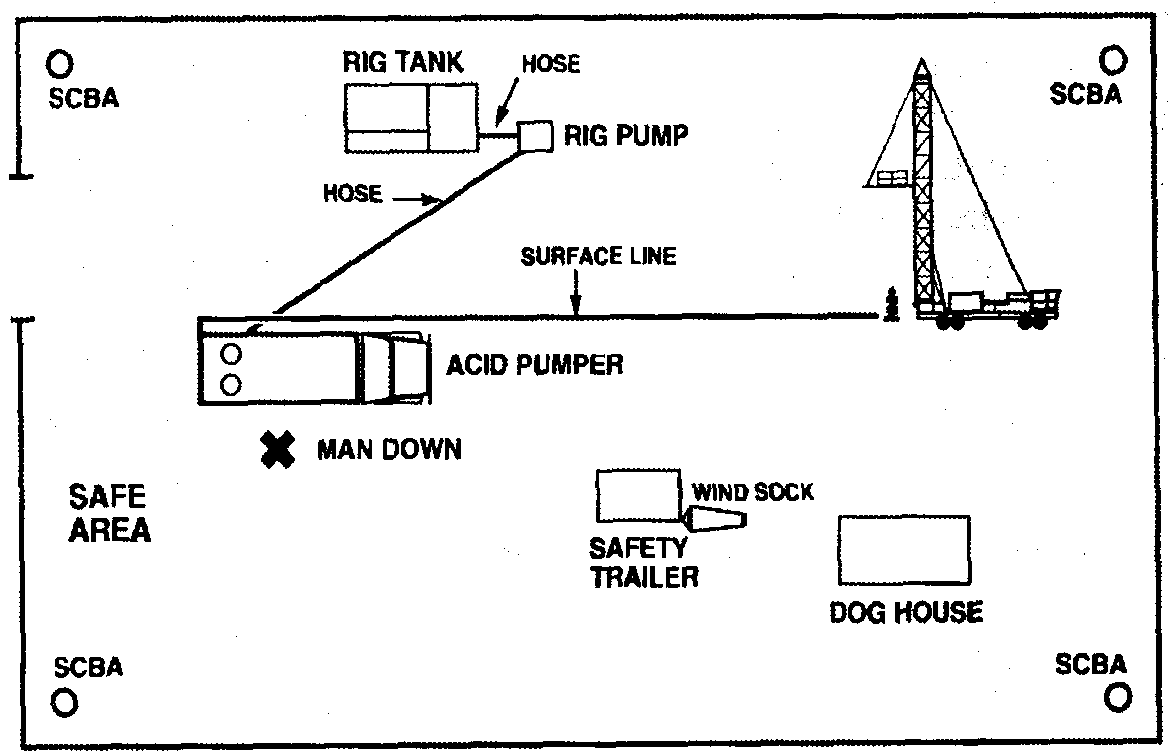
Рисунок 27. Acid treatment.
The day before the alarms had sounded at the rig tank when the well was being circulated. The safety operator checks over the rig with a personal monitor before the safety meeting and finds no H2S. He feels there is no need to supply the pumper operator with a SABA and air hose.
During the safety meeting, the dangers of H2S are discussed and emergency procedures are reviewed. The pumper and rig pump operators ready their units to transfer fluid from the rig tank. The rest of the personnel meet at the rig shack for coffee.
The rig pump operator starts to pump fluid from the rig tank to the pumper. The pumper operator looks in the tank to check the level and collapses on the far side of the truck. The rig pump operator does not see the operator fall and continues to pump. The supervisor comes out of the dog house and sees his operator down and runs toward the pumper. The supervisor goes down as he reaches the unit. The rig pump operator sees the supervisor go down and stops pumping. The portable monitor at the wellhead then goes off.
Describe the mistakes made.
2) WELL SERVICE
A rig crew and air trailer attendant arrive at a location at the same time to start the day. The air trailer attendant unlocks the trailer and proceeds to stretch out the air lines. The rig crew goes into the doghouse to change their clothes.
One man, however, decides to check the shut-in tubing and casing pressure before changing his clothes. Once he records the pressure, he decides to bleed off pressure to an open tank. The return and kill lines had been drained the night before and not reconnected. The build-up pressure is released to the atmosphere.

Рисунок. Well service.
Approximately 2000 ppm of H2S is released into the atmosphere. It migrates downwind directly into the path of the air trailer attendant. He is instantly overcome and collapses near the end of the catwalk.
A second crew man sees the air trailer attendant slump to the ground. He rushes over to assist and is also knocked down. The first crew member realizes what is happening and shuts the wellhead valve.
Describe the mistakes made.
3) DRILLING RIG
Рисунок. Drilling rig.
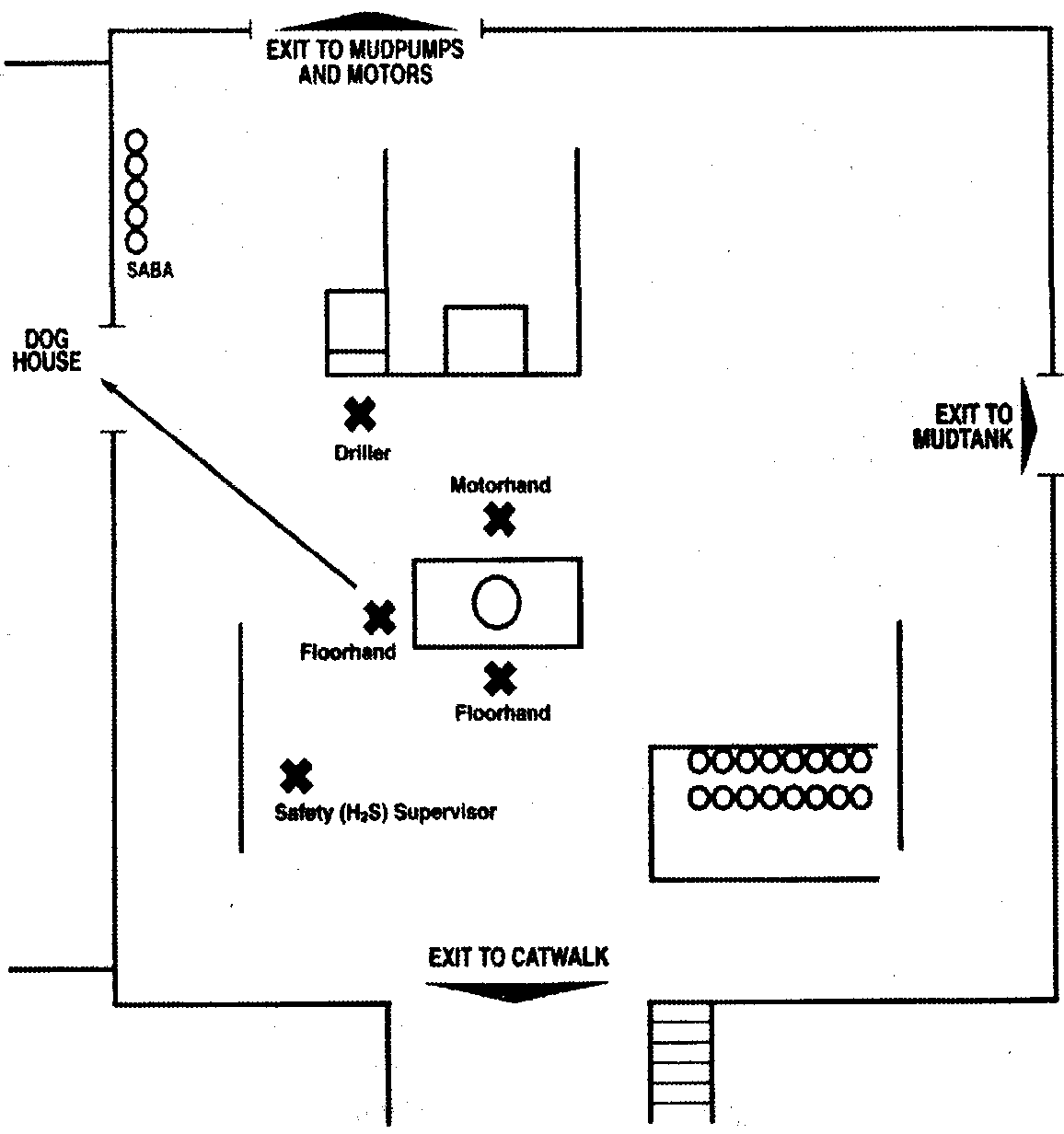
A rig crew was pulling a wet test. The crew members were all masked up. A safety supervisor, also masked up, was testing the floor area with a detector tube device. Several wet stands were pulled, and no H2S had been detected. The safety supervisor suggested the crew take off their masks, as they were tiring quickly. The situation was discussed with the rig manager and the wellsite representative. All agreed the crew should take off their masks. The safety supervisor would remain masked up and would continue testing.
The crew went back onto the floor without masks. A stand was pulled and the tool joint broken. The mudcan was put on, and the crew left the floor. The driller picked up on the stand and the mud drained. The safety supervisor opened the mudcan and tested. No H2S was detected. The crew were called back on the floor to hoist another stand. As they were about to hook on the elevators, a small mud burp was observed. The safety supervisor told the crew to leave the floor, and he began to test.
Three of the crew members were going into the doghouse when the first one went down. Two more went down on top of him. The well was immediately shut in. The three crew members were revived shortly afterwords and taken to hospital. The safety supervisor detected 32% H2S. Describe the mistakes made.
6. MAKE UP A SITUATION AND TALK TO YOUR FRIEND
1. Being a safety man at the rig site explain to the driller why it is dangerous to open valves on the wellhead.
2. As a safety man convince the rig site workers that H2S is dangerous even in small concentrations.
3. You see a derrickman leaving a dog house where he has had lunch with the crew. He has a personal monitor, an air pack on and is going to gauge the tank. Though everything is all right, he is making a mistake. Try to talk to him and explain his mistake.
7. LISTEN TO THE TEXT ON THE TAPE
NEW WORDS
1. Blind - глухой фланец, люк, крышка
2. Production facilities - нефтеочистные сооружения на промысле
3. Refine petroleum - очищать нефтепродукты
4. Scale - накипь, нарост
5. Sewage - сточные воды
6. Sour spills -разлив жидкостей, содержащих H2S
7. Wastewater treatment facilities - водоочистные сооружения
7.1. LISTEN TO THE TEXT AGAIN
7.2. ANSWER THE QUESTIONS
1. What is the origin of H2S?
2. Where is H2S encountered?
3.What are the properties of H2S?
4.Where can you find H2S in oil and gas industry?
5.Why are the confined spaces especially dangerous?
6.What are the main procedures to ensure your safety at an H2S site?
7.3. READ THE TEXT TO CHECK YOURSELF
H2S
Hydrogen sulphide, or H2S, is a naturally occuring gas found in a variety of geological formations. It is also formed by the natural decomposition of organic material in the absence of oxygen. It is encountered in a variety of industrial processes, including sewage and wastewater treatment facilities and the production and refining of petroleum, pulp and paper, metals, sulphur compounds and heavy water. H2S may be referred to as sour gas, acid gas, stink damp or sulphuretted hydrogen.
H2S gas is colourless, heavier-than-air and extremely toxic. In small concentrations it has a rotten egg smell and causes eye and throat irritation. H2S can deaden your sense of smell and, at higher concentrations, causes death. For these reasons, training in how to protect yourself is cruicial in any industry where H2S might be encountered. You will learn more about the toxic effects of H2S later, but first take a look at the following fatality incidents which occurred in the petroleum industry. All of these incidents could have been prevented!
- After loading his tank truck with sour produced water, a truck driver climbed onto the truck tank to gauge his load. His body was found the next morning on top of the tank near the open hatch.
- A boilermaker foreman was exposed to hydrogen sulphide while removing a blind on top of a vessel. After the exposure, he fell 12 m to his death.
- A rig worker collapsed while operating a blow-out preventer valve. The foreman brought breathing apparatus to rescue him, but was overcome. A third worker came to their rescue and was also overcome. The crew finally removed them from the area. The third worker was revived, but the first worker and the foreman both died.
These incidents are not here to scare you, but to point out the dangers associated with H2S. You can control these hazards through receiving adequate training, following safe work procedures and using breathing apparatus.
You can expect to find H2S anywhere in oil and gas industry. This means you can find H2S in:
-wellheads;
- piping systems;
- vessels;
- pipelines;
- tanks;
- production facilities;
- pits and low spots;
- confined or enclosed spaces;
- shacks or buildings;
- sour spills.
You must be cautious when dealing with any confined space. When you enter a confined space, there is always the possibility that H2S may be present. The two main things to watch out for are scale and liquids. If you agitate liquids in a tank, they may release any H2S they contain. The removal of scale by steam, chemicals or grinding may also cause the release of any H2S in the scale.
H2S may be dissolved in liquids and then be released if agitated, depressurized or heated. This means that gas in the liquids is released when they are circulated, pumped, flowed or swabbed into tanks. That is another reason why you would expect to find H2S at the top of open tanks, gauge hatches and vent lines.
If you are near an oil and gas facility, check the wind direction by looking at the windsocks, weather vanes, tape, trees and so on. If H2S is present, it will move downwind. Staying upwind of the facility in the event of a leak should help keep you out of danger.
H2S is heavier than air. This means the gas may collect in low-lying areas or be trapped by buildings, natural barriers or other confined spaces. In the event of a leak, go to high ground upwind from the source of H2S. If downwind, head in a direction that takes you crosswind.
7.5. RETELL THE TEXT
8. MAKE UP A STORY ON H2S AND RETELL IT
LESSON 12
ДОКУМЕНТАЦИЯ
В этом разделе приведены основные виды документов, с которыми приходится работать переводчику в нефтедобывающем предприятии, даны образцы их оформления и упражнения для самостоятельного перевода. Документы могут меняться по размеру и оформлению, при этом, данные для заполнения и перевода остаются сходными. В зависимости от конкретных условий, видов документов может быть гораздо больше, поэтому в тексте данного урока мы ограничимся иллюстрацией нескольких примеров.
Очевидно, что самым распространенным документом в достаточно крупном совместном предприятии является файловая (служебная) записка, при помощи которой осуществляется корреспонденция между отделами. Составляется служебная записка на двух языках. Пример ее оформления приведен ниже.
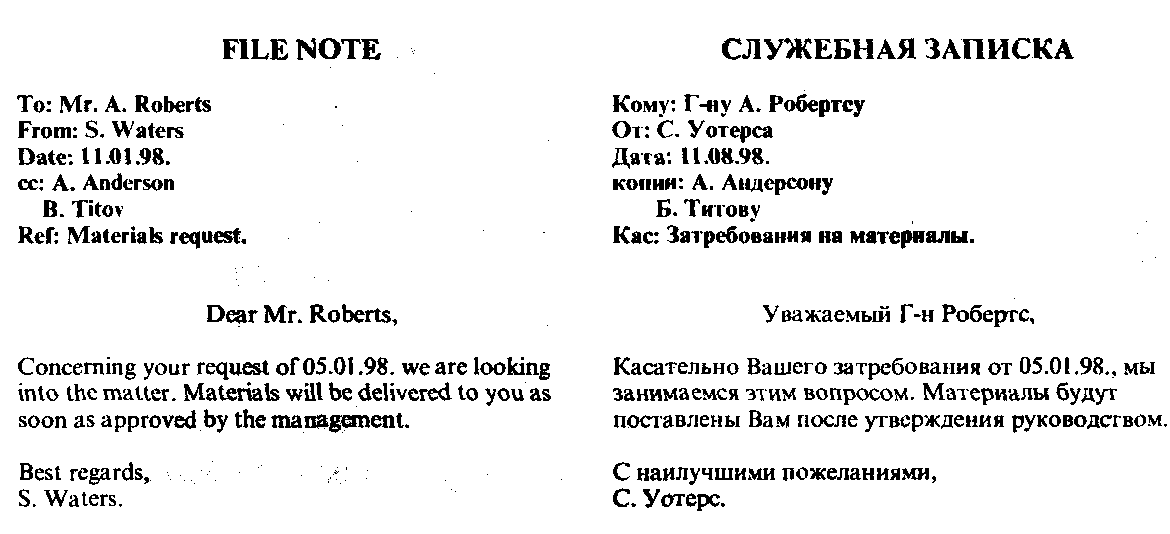
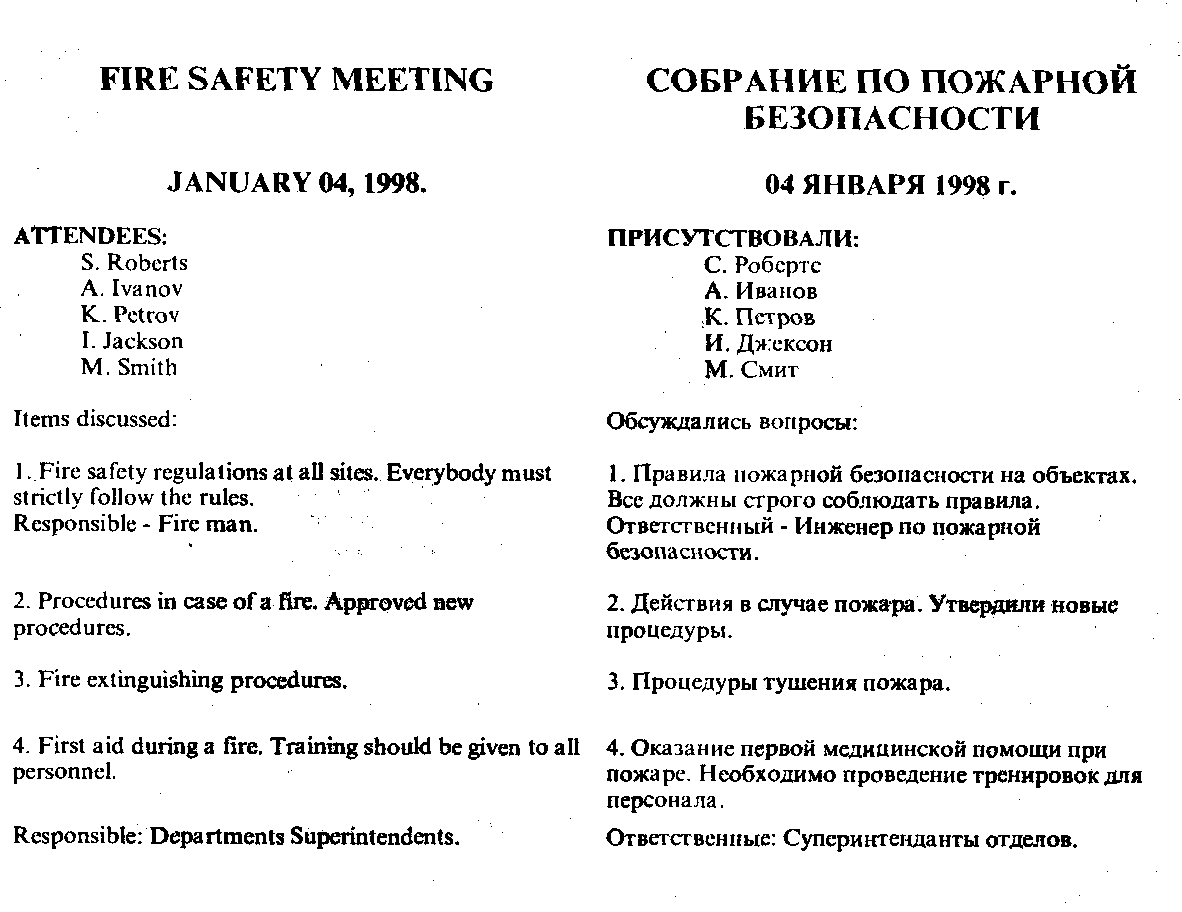
Наиболее сложными в отношении перевода являются документы отделов Бурения и Заканчивания. Трудности, с которыми можно встретиться при оформлении и переводе ежедневных сводок по бурению и заканчиванию, программ по скважинам и других документов, заключаются как в специфичности терминологии, так и в наличии большого количества абривиатур.
Образцы сводок по бурению и заканчиванию, а также образец плана работ по скважине, приведены ниже.
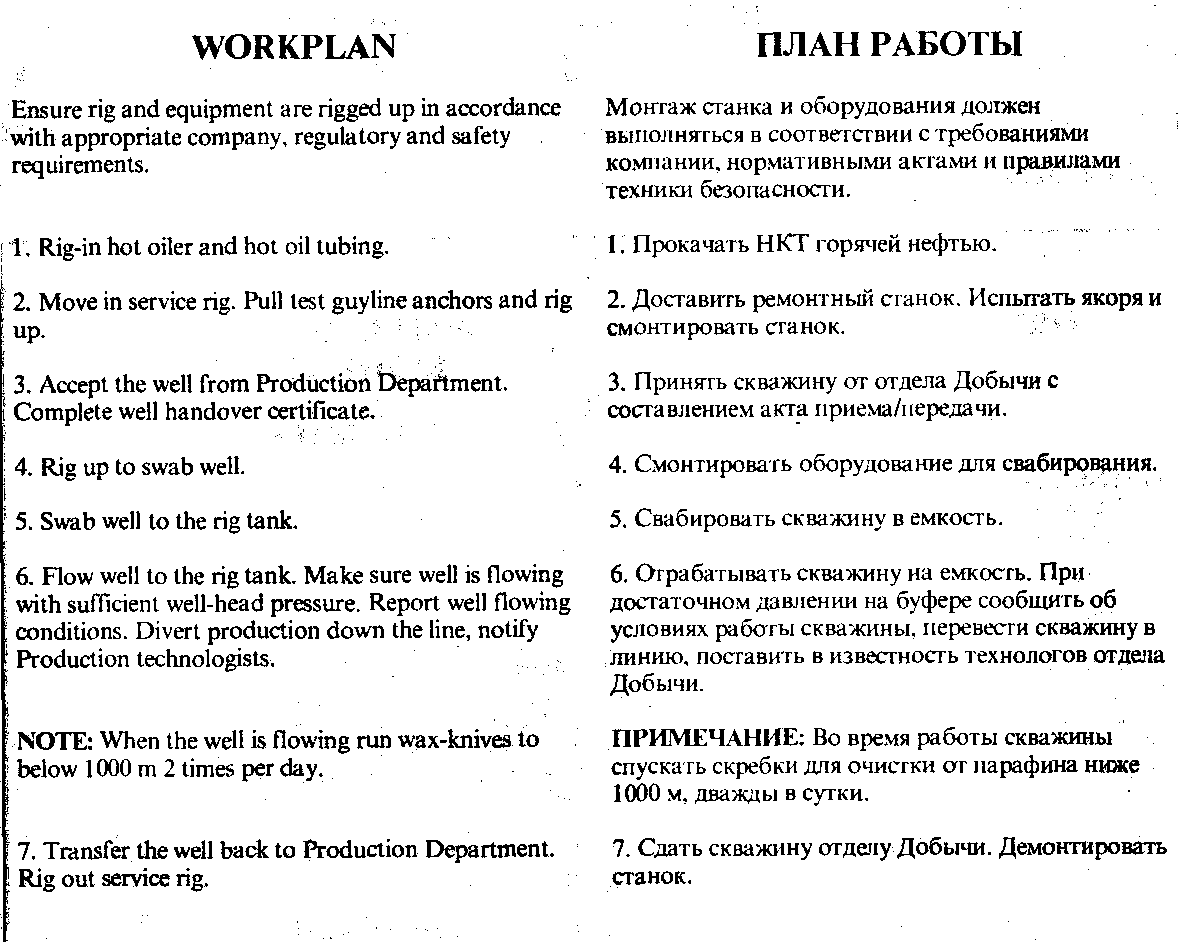
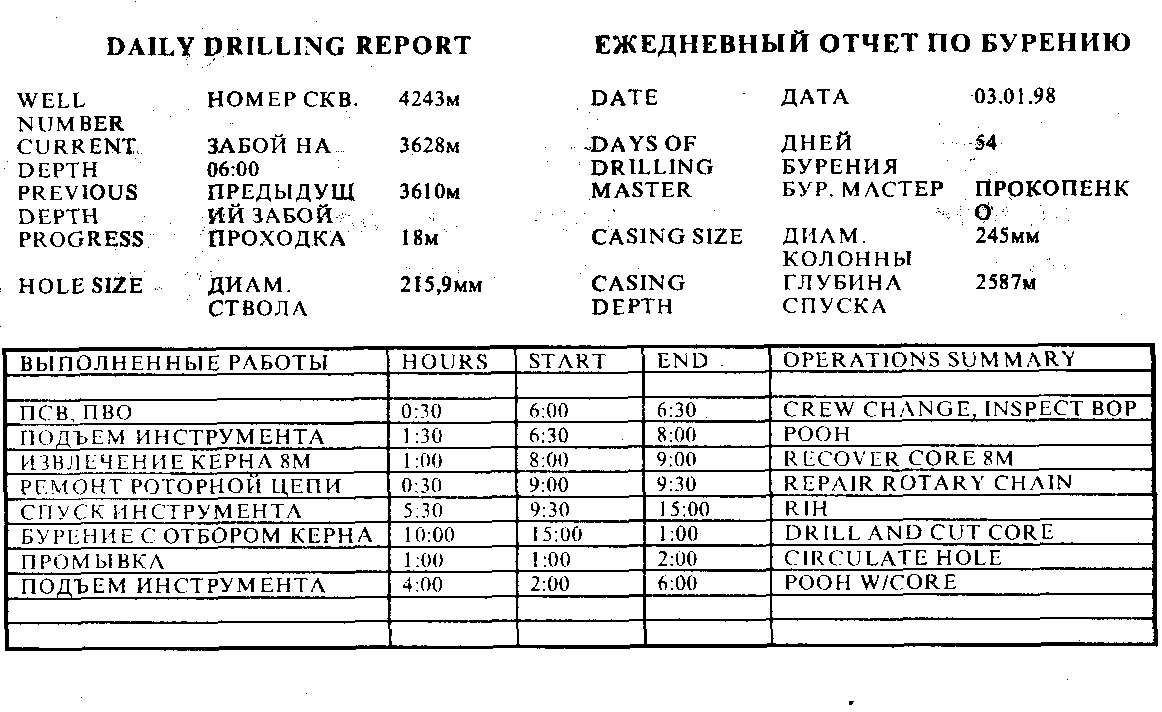

EXERCISES
